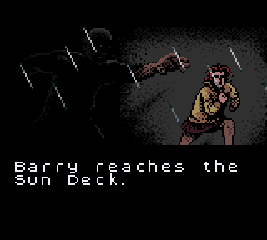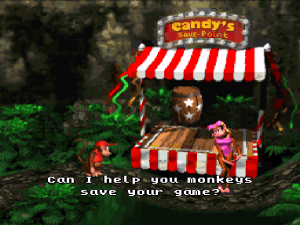
Forget everything I’m about to write about. This is the most intriguing thing in any of these games. Ostrich Beer? Is it beer made from ostriches or for ostriches? How does one make a beer out of ostriches anyway? Or is it regular beer ingredients with ostrich flavoring? What does ostrich taste like? I need answers!
Resident Evil Outbreak, Resident Evil Survivor, and Resident Evil Gaiden

Jeez, it was just a request. I guess some people would rather fake their own deaths than play “The Wreck of the Edmund Fitzgerald.”
Having finished Code Veronica, I’ve come to an end–of sorts–for this series. There are no more games with creepy atmospheres and pre-rendered backgrounds that emphasize weapons and item management while searching for tools to open up branching paths ahead. Of course Resident Evil 4 was a groundbreaking change that invigorated the series, but with its run-and-gun focus on shooting enemies and exploiting boss weaknesses (not to mention a mad scientist named “Albert”), the second half of the series has more in common with Mega Man than with its own predecessors.

This would be a more horrific revelation were it not for the fact that THIS IS THE SCALPEL’S INTENDED PURPOSE. What other scary things are you going to tell us? That the bedpan is full of shit?
But before I move on, there’s a lot of schlock out there. And while I’m not really going to play every Resident Evil game–partially because I now live in New Zealand, which sells region-4 games for my region-1 systems, doesn’t seem to sell used games anywhere, and also has a tendency to censor things it thinks will hurt my delicate brain–I thought I should take at least a cursory look at some of the weird nonsense Capcom has chucked at its fan base over the years.
Resident Evil Outbreak doubles down on Capcom’s insistence that survival horror characters simply shouldn’t be alone. Although considering some of their partner mechanics and AI, it probably is scarier with some schizophrenic meat bag doing whatever the voices in their head tell them. Outbreak gives you all-new ways to be disappointed in your partner, by connecting you online with what I assume are children privately swearing at you like a sailor.
 They also take out any pretense of plot, and instead of Leon, Jill, Chris or Claire, they cast everyone ever rejected from a George Romero film. Seriously, these characters are so mass-produced, I actually heard the first zombie victim shout out, “Hep me! Hep me! I was only three days from mah pension!” Jesus, do we want to black up our faces, bite into a watermelon and strum on de ol’ ban-jo while we’s at it? Whether they were woke to racism or just cliches, even RE2 knew enough not to kill the black guy first.
They also take out any pretense of plot, and instead of Leon, Jill, Chris or Claire, they cast everyone ever rejected from a George Romero film. Seriously, these characters are so mass-produced, I actually heard the first zombie victim shout out, “Hep me! Hep me! I was only three days from mah pension!” Jesus, do we want to black up our faces, bite into a watermelon and strum on de ol’ ban-jo while we’s at it? Whether they were woke to racism or just cliches, even RE2 knew enough not to kill the black guy first.
The first mission begins in a bar, and as such the controls feel half-in-the-bag, and the loading time between rooms is severely diminished. It’s a type of sluggish feeling that would make me say, “Give me your keys, Outbreak. You’re drunk,” but literally the only thing you do is find keys. Or so I thought. I made it to the end of the first mission only to find I needed to start a fire. That thing? I chucked it on the floor at the beginning of the level! Apparently the pocket technology of the Raccoon City Police hasn’t reached the general populace yet, so your pockets can fit a bag of M&Ms so long as you eat a handful first.
I couldn’t even attempt to light a fire with a bullet, since I was limping badly and these zombies are apparently afflicted with the Usain Bolt virus. So I had no choice but to die and restart, but even offering up my tender loins as a peace offering to the zombies ended up a sluggish, tedious affair. My character didn’t have the decency to die when he lost all his health. He just started crawling around like a roomba trailing a pile of cat puke until the viral infection took over and I enlisted in the ranks of cannibals, flesh-eating bacteria, and billionaire capitalists.
Next!

Did…did I just wander into Silent Hill?
Resident Evil Survivor, it turns out, isn’t the steaming tyrannical hell dump I was led to believe. It’s not good, but it isn’t awful. Mostly, it’s just boring. You enter a room, start spraying bullets like you’re auditioning for a Quentin Tarantino film, rinse and repeat. The game is in first person, which is odd for the series, but does make it a little more shocking when a dog takes a surprise bit out of your ass (And that’s when the attack comes—not from the front, but from the other two lickers you didn’t even know were there.) It’s a nice attempt, but the fact that the only limitation on combat is a short pause to breathe every now and then really detracts from any sense of anxiety we might get. Like Outbreak, it’s frustratingly linear, and Capcom has boiled away the intricate escape-room design until the only thing left was a pile of keys, most of which enable you to open doors to access the next key you need. All in all, I’ve had more memorable bowel movements.
Next!

We get it. You’re beautiful. I’d be to if I was scientifically created in a lab. Just put on some damn pants!
“Sure, Resident Evil looks gorgeous and frightening with its beautifully rendered backgrounds powered by Sony’s hardware, but you know where it would really shine? A two-inch screen on an 8-bit system.” And, lo, by that conversation—most likely fueled by a combination of weed and NyQuil—Resident Evil Gaiden was born unto the Game Boy Color. I always forget that Game Boy technology is the Methuselah of video games.

And I-EE-IIII will always love you–ooooo!
So honestly, I expected to play this game for less than an hour and tell you how bad it was in my usual style of strained similes…but I actually finished this one. Yeah. It turns out that this horribly ill-conceived notion of downgrading Resident Evil to processing power straight out of the 80s actually is surprisingly playable. Sure, you still end up unlocking enough keys to feel like you’re questing to become the world’s most powerful janitor, and the soundtrack sounds like a cat sharpening her claws on an old guitar, but the first-person combat system actually held my attention, and wandering around the undead cruise ship actually felt like exploring the Spencer Mansion or the Raccoon City Police Department. They’ve kept an emphasis on conserving bullets and trying to run past zombies without being eaten. The game was challenging without being frustrating, and I was almost all the way through it before I realized how far I’d gotten.

…yeah, he’s definitely coming back.
Don’t get me wrong…it has some flaws. The story is basically a clip show of all the RE games up to that point: they rescue a young girl inexplicably linked with the boss monster, “Did Barry double-cross us? No! He actually triple-crossed Umbrella!”, “The boss just dissolved into a puddle? Obviously he’ll be back for more!”, and they even through in a cliched “Which one is the real Lucia?” scene at the very end of the game. After a few battles, the boss monster stops even pretending to die, and instead just backs away from you with a look on his face like he was trying to toss some spare change in your cup, but then realized you were some stark-raving-mad, diseased hobo.
Not to mention the twist ending, while befitting the horror genre, is inconsistent enough with the rest of the series that doubtless this moment will be debated indefinitely by obnoxious twats on the Internet who insist on hammering every detail of a fictional universe to fit some idea of what is canon. Is he dead? Is he alive? Who the hell cares?

Forget the implications behind Leon having green blood…his lips look like someone kidnapped two earthworms, hog tied them, and threw them in the trunk of a car.

The reputation of the sun deck is greatly exaggerated.

…mostly just to chase those punk kids off his lawn.

Barry is so hardcore paramilitary, this is how he has sex.

And suddenly Cthulu bursts like a Xenomorph from the tyrant’s intestines.

Any of you see that Venture Bros episode where they introduced Fat Chance?






















